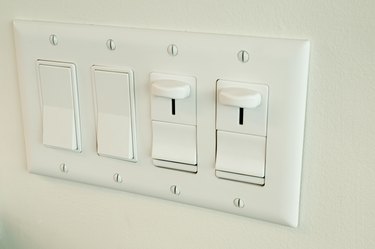
Homeowners are using fluorescent bulbs, both standard tubes and newer Compact Fluorescent Lighting (CFL), more frequently because of reduced energy costs. While incandescent bulbs generate light by heating a tungsten element until it glows white hot, fluorescent tubes generate light by electrically stimulating a phosphorescent coating inside the bulb.
Dimmers, common in household lighting control, adjust the brightness of an incandescent bulb. Electric current in a home changes direction 60 times per second (50 in Europe), and a modern dimmer circuit turns off the power for a brief instant during every oscillation.
Video of the Day
Video of the Day
Standard Fluorescent Bulbs and CFL's
Fluorescent bulbs rely on a flow of electricity to be conducted through an ionized gas. When first turned on, it takes a second or so to create this conduction path, and this is the reason why fluorescent bulbs turn on slowly.
A conventional light dimmer interrupts the flow of electricity briefly many times per second, and this interruption in current flow shuts off the ionized conduction path through the bulb. As a result, a fluorescent light will be in a constant state of restarting if you attempt to dim it with a conventional lamp dimmer. The most likely result is that the fluorescent bulb will not light when you attempt to dim it.
There are specially designed light dimmers that will work for fluorescent lighting. These dimmers will function only with certain ballasts installed in the fluorescent light fixtures. Consult the manufacturer for specific switch and ballast compatibility.
Dimmable Fluorescent Bulbs
In 2009, CFL bulbs that can be dimmed became commercially available. These bulbs have special circuitry contained in the bulb that allows light output to be lowered by approximately 50 prcent.
These bulbs work with standard rotary or slide dimmer switches commonly installed in homes. Because of the much lower energy consumption of fluorescent lighting as opposed to incandescent, electricity savings with a dimmer are minimal.
Summary
A common fluorescent bulb will not work with a dimmer installed for incandescent lighting. There are special dimmers and ballasts which, when used together, provide the fluorescent lighting that can be dimmed. Because of the added expense of these fixtures, they are common only in commercial applications.
CFL bulbs with added circuitry to allow dimming by standard lamp dimmers are now available.